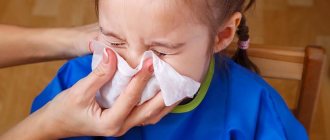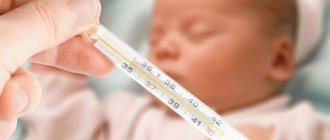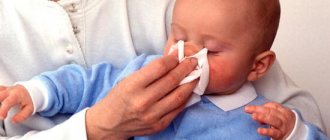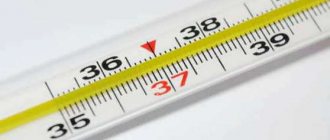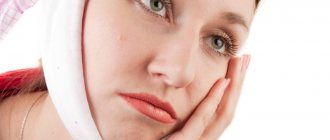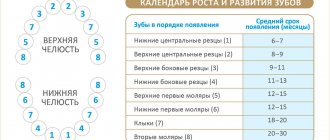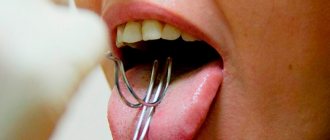When snot appears in a baby, when other signs such as fever, cough, red throat are absent, we can say that the cause is a runny nose during teething. After the teeth appear, the snot usually disappears. During this period, the baby's immune system is weakened, which can cause a risk of contracting a viral infection.
- The connection between runny nose and teething
- Causes of runny nose during teething in children
- Signs of snot in a child
- Features associated with ARVI
- How to help a child
- What parents should not do when treating snot during teething in children
Causes of runny nose during teething in children
A newborn’s first teeth appear between 4 and 7 months of life; usually by the age of three they fill the child’s entire mouth. During this period, the baby is introduced to the first complementary foods and the proportion of breast milk decreases, which leads to a weakening of the child’s immunity . After all, milk contains a large number of antibodies, because they protect the baby from viruses.
The period when teeth are cut becomes difficult not only for the baby, but also for the whole family. The child becomes restless, cries and constantly puts foreign objects into his mouth. In addition, the baby develops a runny nose .
Signs of snot in a child
Symptoms of snot on teeth are:
- increased salivation,
- the child does not sleep well,
- the baby's appetite has decreased,
- diarrhea appeared.
During teething, the baby's temperature may rise . This is explained by a large accumulation of active components. If the temperature rises above 38 and lasts more than three days, parents should definitely contact their pediatrician.
A baby’s snot may also be accompanied by a cough. A large amount of mucus forms in the child’s mouth, which, when it gets into the back of the throat, irritates it and causes a cough. In this case, you also need to make sure that the cough is not caused by a virus, but is associated with teething.
Treatment of teeth grinding
If a baby grinds his teeth in his sleep, special treatment is not always needed. If a symptom of lower jaw tremor appears in a one-month-old baby, this is an alarming sign. The mother should pay attention to how the baby takes the breast, at what time the jaw spasm or trembling of the chin appears. A consultation with a neurologist is required. It is possible that during pregnancy or childbirth the baby suffered a brain injury or suffered from hypoxia.
When a 7-8 month old baby begins to grind his jaws, the pediatrician may recommend a gel for easy teething. Experienced mothers purchase cooling silicone teethers in advance, against which the infant scratches his gums.
If the analgesic effect of cooling or dental gel is insufficient, the baby is given paracetamol or ibuprofen syrup. They relieve inflammation from the gums, eliminate pain and swelling.
In autumn and winter, a 4-5 month old child experiences calcium deficiency. At this time of year, the number of sunny days decreases, and the need for the mineral increases. Calcium is absorbed from milk if there is enough vitamin D in the intestines. It is produced under the influence of ultraviolet radiation. If there is a lack of sunlight, the vitamin is low, so it is necessary to take it in the form of an aqueous solution of drops. Vitamin D will not harm a one-year-old baby or schoolchildren in the winter. The dosage of the drug is selected by the pediatrician individually, so as not to cause a state of hypervitaminosis, which is dangerous for the kidneys.
Treatment of creaking, which often appears after overexertion or stress, is carried out with sedatives. For children, the doctor may prescribe sedatives of herbal origin or herbal teas with mint, valerian, motherwort and other combinations.
If the pediatrician cannot determine why the child continues to grind his teeth, an examination by a dentist is necessary. The doctor will grind off the protruding fillings and check the function of the temporomandibular joint. For periodontal inflammation and caries, he will prescribe special treatment. An incorrect bite is a reason to contact an orthodontist. He will select a mouthguard to protect your tooth enamel from being worn away. If the bite is defective, the use of braces or a corrective plate will be required, which is removed at night.
If there is a repeated creaking or the appearance of convulsive contractions in other muscle groups, be examined by a neurologist. The result of the electroencephalogram may indicate a mild form of epilepsy. For treatment, the doctor will prescribe anticonvulsants. They will help reduce the frequency and severity of attacks. If you refuse therapy, this phenomenon will occur more often and more severely.
Features associated with ARVI
If snot appears on the teeth, parents need to consult a pediatrician or understand that there are no reasons for concern. Komarovsky believes that a runny nose during teething cannot always be treated.
Viral runny nose can be characterized by the following reasons:
- a child, even before the causes of the disease appear, becomes lethargic, his appetite worsens, weakness and pain in the muscles may be observed,
- an increase in body temperature to high values. Although a temperature may be observed during teething, the fever is more pronounced with the virus. If the cause is teeth, then after a few days the temperature disappears without a trace,
- snot, dry or wet cough can be the cause of upper or lower respiratory tract disease. A dry or wet cough that does not go away within three days is possibly viral in nature. Komarovsky believes that teeth in combination with a cough can be the cause of the disease, and hard breathing without wheezing is a residual symptom of a previous viral disease,
- An infectious runny nose is accompanied by impaired nasal breathing and a large amount of mucus secreted. With a virus, the discharge can be mucopurulent, but when it erupts, it is usually transparent.
Runny nose and teeth
Answered by Komarovsky E. O.
Teething is very often accompanied by a runny nose, and any practicing pediatrician can confirm this. The described phenomenon is usually explained by the fact that the process of teething is often accompanied by a decrease in local immunity, and this in turn significantly increases the likelihood of a viral infection. However, quite often a runny nose during teething cannot be explained by any viruses. The child’s condition is not disturbed, there is no increase in body temperature, an excellent appetite, and all that is there is, as you write, “transparent snot, not very much,” and plus teething. Again, such a runny nose can last for weeks, which is at least not typical for an acute viral infection. There is, apparently, another mechanism for a runny nose during teething. The blood supply to the gums and nasal mucosa is closely related anatomically. When teething, blood circulation in the gums is activated, and this inevitably leads to increased blood supply to the nasal cavity. The consequence of the latter is more active work of the glands of the mucous membrane. Hence the additional mucus - transparent and in small quantities. As in your example. So a moderate runny nose during teething with normal body temperature and undisturbed general condition may well be considered as a variant of the physiological norm. Inflammatory processes affecting the airways, especially the bronchi, almost always change the volume of exhalation - it can be heard just as well as inhalation. Such breathing, in which the volume of inhalation and exhalation is the same, is called hard. Thus, the doctor can hear hard breathing when the bronchial mucosa is inflamed (with bronchitis), as well as in a situation where there is dry mucus on the surface of the bronchi: this mucus makes the inner surface uneven, so breathing noise occurs both when inhaling and exhaling. If there was a lot of mucus, if it accumulated in the lumen of the bronchi, then the doctor would definitely hear wheezing. There is no wheezing - not a lot of mucus, “feels good” - serious inflammation in the bronchi is extremely unlikely. Most likely, both cough and hard breathing are residual manifestations of a previous acute respiratory viral infection, caused by the presence of dried mucus on the surface of the bronchi. It's not dangerous, time and fresh air heal it. Walk a lot, moisten and ventilate the children's room, don't be nervous and don't beg for medicine. All answers
How to help a child
A runny nose during teething, as Dr. Komarovsky explains, needs to be treated for inflamed gums. To do this, you can use anti-inflammatory gels - Kamistad and Kalgel. If the symptoms do not disappear for a long time, then the child can be given antiviral drugs approved for teething.
In order for your baby to recover faster, he needs:
- use narrowing drops for no more than six days,
- give plenty of fluids to drink, especially raspberry tea,
- it is necessary to maintain optimal air temperature and humidity in the baby’s room,
- do not force him to eat if the child has no appetite,
- If necessary, maintain bed rest.
To alleviate a child’s condition with a runny nose and snot, he can be helped as follows:
- rinse the nose with saline solution to relieve inflammation and remove mucus,
- use an aspirator to remove mucus,
- If your nose is stuffy, you can use drops to relieve swelling of the nasal mucosa.
Drops that can be used by children when teething are Otrivin, Nazivin and Aqualor.
You can constantly rinse your child’s nose with saline solution several times a day, because it is harmless and has no contraindications.
Sometimes the contents of the child’s nasal sinuses dry out, full access to breathing ceases and moisture occurs. To prevent the occurrence of a runny nose, it is necessary to avoid the appearance of dry crusts.
To prevent dry crusts in a child, you need to:
- rinse thoroughly and constantly moisturize your nose,
- prevent the appearance of mucus with special preparations.
Comparative characteristics
To make it easier for parents to navigate the clinical features of rhinitis in infants, the table below provides a comparative description of various types of runny nose with characteristic symptoms and signs.
How to distinguish dental rhinitis from pathological runny nose?
| Criteria (signs and symptoms) | Physiological secretion of nasal mucus | Infectious rhinitis | Allergic rhinorrhea |
| Appearance of snot | The snot has a watery, transparent consistency that persists even after several days. They have no color. | With viral infections, snot is usually watery and has increased viscosity and fluidity. If a bacterial infection is added to a viral infection, the snot becomes thick and acquires a yellowish, green or swampy tint. | The discharge is transparent, has a low degree of viscosity, and some of it causes irritation to the skin under the nose. |
| Number of snot | Moderate to very heavy. | Light to moderate. | From light to very heavy. |
| Smell of mucus | Absent. | With bacterial infections or severe atrophy of the nasal mucosa, the discharge may have a strong, foul odor. | Absent. |
| Factors preceding the appearance of snot | Mucus is released randomly. | The appearance of rhinorrhea is usually preceded by hypothermia, contact with a sick person, or other risk factors for viral and bacterial infections. | A runny nose occurs after contact with various pathogens (dust, animal hair, some foods, etc.). |
| Cough | Available. | Appears almost always. | Possible, often accompanied by itchy nose and sneezing. |
| Body temperature | Normal (moderate hyperthermia is possible within the range of low-grade fever, associated with the fact of painful teething). A physiological increase in temperature to 37.3°-37.5°C lasts no more than 1-2 days. | Increased (may exceed low-grade levels and be accompanied by febrile fever). | Normal. |
An infectious runny nose is also characterized by nasal congestion, impaired nasal breathing, and the appearance of other symptoms of various respiratory diseases.
If your child has a fever, you should call a pediatrician
With allergic rhinorrhea, a child may experience skin itching, rashes and other signs of allergy typical for this group of diseases.
